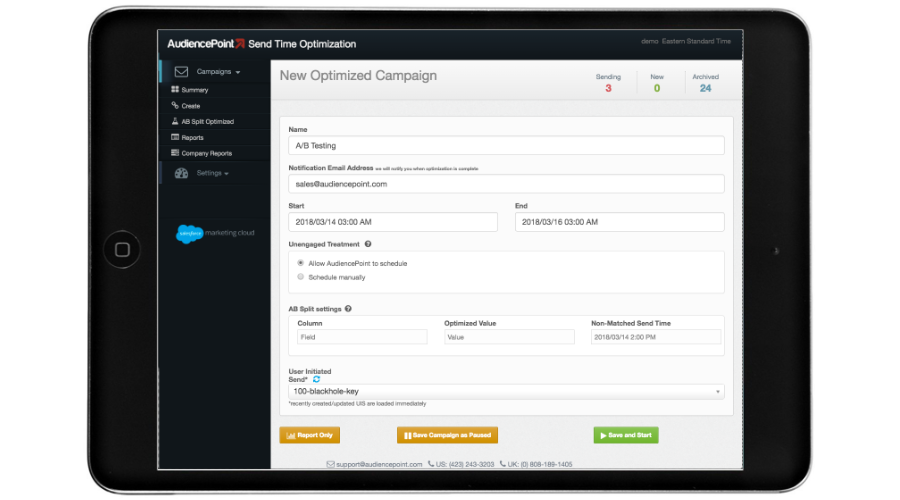In email marketing nothing is more important than making sure your subscribers get your emails. Understanding email deliverability...
Marketers who are trying to reduce bounces and improve email engagement often come across terms like deliverability score and sender score. These can be useful metrics to help you see what areas of your email marketing efforts need to be improved.
However, you’re probably left wondering, what is a good email deliverability score? How can I make efforts to improve a low sender score? Don’t worry, we’ll cover everything for you in this article. Keep reading for all the details.
Understanding Email Deliverability Scores
Delving into the world of email marketing, you’ll frequently encounter terms like “email deliverability score.” This metric is pivotal, acting as a health check for your email campaigns. But what exactly does it entail? Simply put, an email deliverability score assesses the likelihood of your emails reaching the subscribers’ inboxes, avoiding the spam folder or getting lost in cyberspace. Calculated by ISPs (Internet Service Providers) and email service platforms, this score hinges on various factors, including sender reputation, content quality, and recipient engagement. It’s a barometer for your email campaign’s pulse, ensuring your messages not only depart your outbox but also land precisely where intended.
Which Factors Determine the Deliverability of Emails?
Several factors contribute to the deliverability of emails. When checking deliverability scores, these will be some of the key aspects that’ll factor into it:
- Sender Authentication: Implementing proper sender authentication protocols, such as SPF, DKIM, and DMARC, can significantly improve your email deliverability score. These measures verify the authenticity of your emails and build trust with email providers.
- Spam Triggers and Filters: Avoiding common spam triggers, like excessive use of capital letters, exclamation marks, or certain keywords, helps prevent your emails from being flagged as spam. Additionally, understanding how spam filters work and adhering to their guidelines ensures your messages have a higher chance of reaching the inbox.
- Bounce Rates: Keeping your email bounce rates low is crucial for maintaining a good email deliverability score. High bounce rates indicate that your email list may contain invalid or inactive email addresses. Regularly cleaning your list and removing dormant addresses by using an email bounce checker can improve your overall deliverability.
- Engagement Metrics: Email engagement metrics, such as open rates, click-through rates, and subscriber interactions, play a significant role in determining your deliverability score. Higher engagement signals to email providers that your emails are valuable and wanted, resulting in better inbox placement.
- Complaints and Unsubscribes: The number of spam complaints and unsubscribes you receive can impact deliverability. Minimize complaints by providing clear unsubscribe options and delivering relevant content to your subscribers. Monitoring and promptly addressing complaints can help maintain a positive reputation with email providers.
While these won’t be the only factors, these should be some of the primary areas you look into if you discover you have a low sender score.
What Constitutes a Good Email Deliverability Score?
Navigating the realm of email marketing metrics, one often wonders, “What’s a golden score that guarantees my emails a front-row seat in the inbox?” While the answer varies, a deliverability score north of 90% is generally considered the Holy Grail. Achieving and maintaining such a score signifies that the vast majority of your emails are warmly welcomed by recipients’ inboxes, fostering healthy engagement and sender reputation. However, this benchmark isn’t set in stone. Depending on your industry and the peculiarities of your audience, a “good” score might have different connotations. It’s about understanding the nuances and striving for that optimal inbox placement.
Is Sender Score Legit?
When researching how to improve email deliverability, you may have heard some advice to do a sender score check. The sender score is a real representation of an estimated sender reputation. It’s based on data from over 100 mailbox providers globally.
However, it’s important to remember that it’s just an estimate. The sender score does try to consider lots of data and factors. However, every inbox provider has several factors contributing to how they flag content as spam and when they decide to bounce emails.
Ultimately, it’s best to check the sender score and use best practices to ensure the health of your email list and the best deliverability of your content.
Can You Check Sender Score Free?
Many also wonder about doing an email sender score check for free. The official Sender Score website does allow you to check your score for free. It’ll show you that your domain has a properly registered SSL, your SPF is set up correctly, and several other key indicators that you’re following best practices along with your score.
However, it’s important to remember this is just an estimate from a free tool. If you want to deploy email marketing best practices, you need more advanced tools and software to get the best results.
At AudiencePoint, we have an email address verification tools that can help. If you’re struggling with deliverability, we can make solving it easy. Our insight software will track how your subscribers are engaging with their inbox and provide you with actionable data on areas where you can improve.
Everything will be easy to implement, so you don’t have to do a lot of searching and tests to find the answers on your own. That way, you can easily segment campaigns, re-engage inactive subscribers, and suppress dormant email addresses to improve deliverability.
What Is a Good Sender Score?
Typically, an email sender score of 70 or above is considered good, and 80 or above is considered excellent. There’s always room to improve and things you must stay on top of in email marketing, but if you’re in this range, there will be little to no major things you must do for your deliverability.
What Is a Bad Sender Score?
A sender score in the 60s shows that there’s room for improvement. Anything below 50 is usually considered in the bad range, where there are significant steps you should take to improve deliverability.
Strategies to Improve Your Email Deliverability Score
Found your score wanting? Fear not. Elevating your email deliverability score is akin to fine-tuning a musical instrument; it requires patience, precision, and a bit of savvy. Here’s how to hit the high notes:
- Optimize Your Email Content: Craft emails that resonate. From compelling subject lines to engaging, relevant content, every element should sing to your audience, encouraging clicks and interactions.
- Maintain Pristine List Hygiene: Regularly scrub your email list clean of inactive or unresponsive addresses. This not only boosts your engagement rates but also minimizes bounces, keeping your sender reputation spotless.
- Enhance Sender Reputation: ISPs keep a close eye on your sending habits. Ensure your authentication protocols (SPF, DKIM, and DMARC) are in place and your sending volume is consistent, without spikes that might raise eyebrows.
- Engage, But Don’t Overwhelm: While engagement is key, bombarding inboxes is a surefire way to irk your audience. Tailor your email frequency to their preferences, keeping your presence welcome but not overwhelming.
Adopting these strategies doesn’t just polish your deliverability score; it transforms your email marketing into a fine-tuned engine of engagement, driving your messages home every time.
How Can I Improve My Sender Score?
If you’re in that 50-60 range of sender scores, there are some key ways to improve sender scores to get into the good range. That includes:
- Implement proper sender authentication protocols, such as SPF, DKIM, and DMARC, to verify the authenticity of your emails and build trust with email providers.
- Keep your email list clean and up-to-date by regularly removing bounced or inactive email addresses to maintain a low bounce rate.
- Monitor and address spam complaints promptly, provide clear unsubscribe options, and deliver valuable content to minimize complaints and unsubscribes.
- Pay attention to engagement metrics like open and click-through rates, as higher engagement signals to email providers that your emails are desired and valuable, leading to improved sender scores.
Overall, these are email marketing best practices everyone will benefit from implementing.
How Do I Fix a Low Sender Score?
If your sender score is in the low range, there are some ways you can fix it and get back on track, including:
- Improve your email engagement by creating compelling content, optimizing subject lines, and encouraging recipients to interact with your emails through clear calls to action.
- Identify and address the underlying issues causing a bad sender score, such as high bounce rates, spam complaints, or low engagement, and take corrective actions to rectify them.
- Evaluate your email-sending practices, such as frequency and volume, to ensure you are not overwhelming recipients’ inboxes and adjust them to align with the preferences of your subscribers.
Besides these points, many other factors can affect the sender’s score and deliverability. If you’d like additional help, AudiencePoint will be a great resource for your needs.
How AudiencePoint Can Help
AudiencePoint is an email insight software that can help you improve deliverability.
Our software stands out amongst other options because we use several methods to provide the best insights. One of those is using second-party data to provide additional metrics to help identify dormant email addresses and verify your email list.
AudiencePoint also helps you optimize send times, get data in real-time, and get insights into how your subscribers engage with content.
These tools will help you clean up your email list and optimize for success. Contact us today to learn more!




